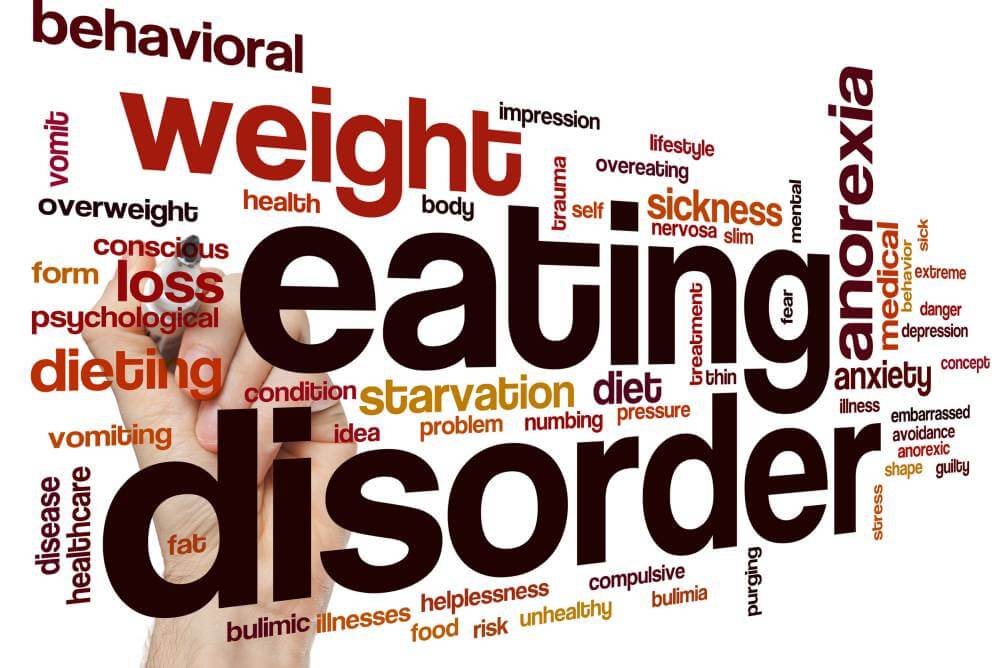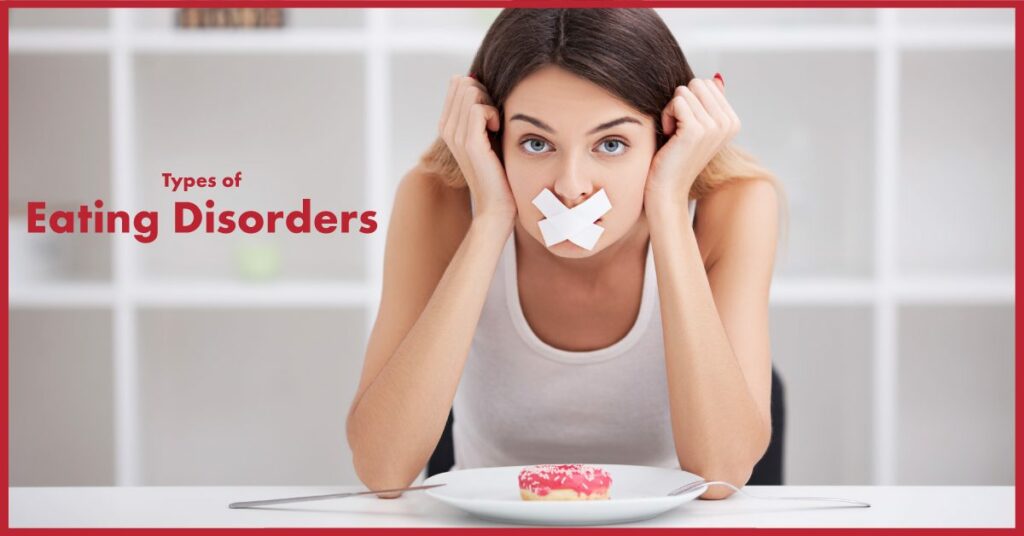Eating disorders are serious mental health conditions that can affect anyone, regardless of age, gender, or weight. If you think you or someone you know may have an eating disorder, it’s important to know the different types of eating disorders and how to get help. In this blog post, we will discuss the four most common types of eating disorders: anorexia nervosa, bulimia nervosa, binge-eating disorder, and EDNOS (eating disorders not otherwise specified). We will also provide information on how to get help for an eating disorder.
Contents
What Are Eating Disorders?
 Eating disorders are mental disorders that cause abnormal or disturbed eating habits. These Eating disorders can lead to serious health problems and even death. Eating disorders are not just about food; they are also about a person’s emotional and mental state.
Eating disorders are mental disorders that cause abnormal or disturbed eating habits. These Eating disorders can lead to serious health problems and even death. Eating disorders are not just about food; they are also about a person’s emotional and mental state.
There are four main types of eating disorders: anorexia nervosa, bulimia nervosa, binge-eating disorder, and EDNOS (eating disorders not otherwise specified).
There are many signs of eating disorders. Some common signs of anorexia nervosa include weight loss, preoccupation with food and weight, excessive exercise, and denial of hunger. Bulimia nervosa is characterized by binge eating followed by purging (vomiting or using laxatives). Binge-eating disorder is similar to bulimia nervosa but without purging. EDNOS is a catch-all category for eating disorders that don’t fit into the other three categories.
Also, there are many causes of eating disorders. The cause of an eating disorder is not fully known, but it is thought to be a combination of genetic, psychological, and environmental factors. There can be many negative consequences of having an eating disorder. These consequences can be physical, mental, and emotional. Eating disorders can lead to serious health problems and even death.
If you think you or someone you love may have an eating disorder, it’s important to get help. There are many resources available to help people with eating disorders. Treatment for eating disorders often includes counseling, support groups, and in some cases, medication. If you are struggling with an eating disorder, know that there is help available and you are not alone.
If you think you or someone you know has an eating disorder, it’s important to get help. Eating disorders can be treated, but they often require professional help. If you are worried about someone with an eating disorder, the best thing to do is talk to them about your concerns.
What Are the Different Types of Eating Disorders?

As we mentioned before, there are four main types of eating disorders: anorexia nervosa, bulimia nervosa, binge-eating disorder, and EDNOS. Let’s take a closer look at each type of eating disorder.
Anorexia Nervosa
Anorexia Nervosa is an eating disorder that is characterized by an intense fear of gaining weight and a severe restriction of food intake. People with anorexia nervosa often see themselves as overweight, even when they are underweight. Anorexia nervosa can lead to serious health problems and even death. This type of disorder is most common in adolescent girls and young women, but it can affect people of any age, gender, or weight. People with anorexia nervosa often have a distorted view of their body and see themselves as overweight, even when they are underweight.
When someone has anorexia nervosa, they may:
-Have a fear of gaining weight or becoming fat
-weigh themselves frequently
-Restrict their food intake
-Exercise excessively
-Have a distorted view of their body weight and shape
Anorexia nervosa is a serious, life-threatening illness. If you think you or someone you know has anorexia nervosa, it’s important to get help. Anorexia nervosa can be treated, but it often requires professional help. Treatment for anorexia nervosa often includes counseling, support groups, and in some cases, medication.
Bulimia Nervosa
Bulimia Nervosa, more commonly known as bulimia, is an eating disorder where a person will binge eat and then force themselves to vomit or use laxatives to prevent weight gain. Also, Bulimia is a very serious eating disorder that can lead to long-term health problems, including heart problems and kidney failure. If you think you or someone you know may have bulimia, it is important to seek professional help immediately.
In bulimia, a person often feels like they have no control over their eating. They may feel like they need to binge eat to satisfy their hunger, but then feel guilty and ashamed afterward. This can lead to a cycle of binging and purging that can be very difficult to break without professional help.
Binge-Eating Disorders
Binge-eating disorder is the most common eating disorder in the United States. It is characterized by episodes of overeating, feeling out of control, and then feeling guilty afterward. People with binge-eating disorders often eat when they are not hungry and continue eating even after they feel full. They may try to diet or purge afterward, but this doesn’t always happen.
When a person binge eats, they may eat very quickly, even to the point of feeling stuffed. They may feel that they can’t control how much they’re eating and are often embarrassed by how much they’ve eaten when the episode is over. Bingeing can be a response to stress or other negative emotions. It can also be a way of numbing oneself from difficult feelings or situations.
PICA Disorder
PICA Disorder is a disorder where people compulsively eat non-food items. This can include dirt, paint chips, hair, ice, stool, and other inedible things. People with PICA often don’t know that what they’re eating is not food or they may be unaware that it could be harmful to them.
PICA is considered a disorder when the behavior persists for more than a month and causes distress or impairment. It is most common in children and pregnant women. PICA can be a sign of other underlying mental health disorders such as OCD or schizophrenia. PICA can also be a response to iron deficiency or other nutritional deficiencies.
Purging disorder
Another type of eating disorder is purging disorder. This is different from bulimia nervosa in that people with purging disorder don’t binge eat before they purge. Instead, they purge after eating normal or small amounts of food. People with purging disorder may use laxatives, enemas, or self-induced vomiting to rid their bodies of the food they’ve eaten.
Like other eating disorders, purging disorder is characterized by a preoccupation with body weight and shape. People with purging disorder may feel like they can’t control their eating and are often ashamed of their behavior. Purging Disorder can lead to serious medical complications such as dehydration, electrolyte imbalances, and heart problems.
Night-Eating Disorder
An eating disorder that is often mistaken for bulimia nervosa or binge-eating disorder is a night-eating syndrome. People with this disorder eat most of their food at night or late at night. They may wake up in the middle of the night to eat and have trouble falling back asleep.
People with the night-eating syndrome often feel like they can’t control their eating and are ashamed of their behavior. They may feel guilty about how much they’re eating and try to diet during the day, but this doesn’t always work. Night-eating syndrome can lead to weight gain and other medical complications such as type II diabetes.
Restrictive Food Intake Disorder
Restrictive food intake disorder is an eating disorder where people severely restrict the amount of food they eat. This can be due to a fear of gaining weight, a dislike of certain foods, or other reasons. People with restrictive food intake disorder may become malnourished and can have serious medical complications as a result. In restrictive food intake disorder, people may also have a preoccupation with body weight and shape.
Sometimes people with restrictive food intake disorder will also have an eating disorder called anorexia nervosa. Anorexia nervosa is characterized by a fear of gaining weight, a preoccupation with body weight and shape, and a refusal to maintain healthy body weight. People with anorexia nervosa may also have restrictive food intake disorder.
Ruminative Disorder
A ruminative eating disorder is characterized by a person’s obsession with food and body weight. This can often lead to binge eating and purging behaviors. People with this type of disorder often have a hard time sticking to a strict diet, as they are constantly thinking about food. If you or someone you know is exhibiting these symptoms, it is important to seek professional help.
Orthorexia Nervosa
Orthorexia Nervosa is an unhealthy obsession with healthy eating. People with this disorder often become fixated on the quality of the food they are consuming, to the point where they will only eat certain “safe” foods that they deem to be healthy. This can often lead to social isolation and malnutrition, as orthorexics are often too afraid to eat anything that they deem to be unhealthy. If you or someone you know is exhibiting these symptoms, it is important to seek professional help.
Common Signs of Different Types of Eating Disorders

There are many different types of eating disorders, each with its own set of symptoms and signs. However, some common signs may be indicative of an eating disorder. If you or someone you know is exhibiting any of the following behaviors, it is important to seek professional help:
extreme restriction of food intake
This is one of the most common signs of anorexia nervosa, an eating disorder characterized by severe restriction of food intake. Individuals with anorexia may engage in behaviors such as fasting, excessive exercise, and/or purging (via vomiting or the use of laxatives) to lose weight.
bingeing and purging
This is a common sign of bulimia nervosa, an eating disorder characterized by bingeing (eating large amounts of food in a short period) followed by purging (getting rid of the food through vomiting or the use of laxatives). Bulimics often feel out of control during a binge and use purging as a way to “make up for” the binge.
compulsive exercise
This is a common sign of both anorexia and bulimia nervosa. Individuals with eating disorders often exercise excessively to burn calories and/or prevent weight gain.
obsession with food, weight, and/or body image
This is a common sign of all eating disorders. Individuals with eating disorders often think about food, weight, and body image obsessively. They may be preoccupied with thoughts of how to lose weight or how to make themselves look better.
an unhealthy focus on appearance
This is a common sign of all eating disorders. Individuals with eating disorders often have an unhealthy focus on their appearance. They may be overly concerned with their weight, body shape, and/or clothing size.
Common Causes of Different Types of Eating Disorders

There are many different types of eating disorders, and each type has its own set of causes. Here are some of the most common causes of different types of eating disorders:
Genetics
One of the most common causes of eating disorders is genetics. If you have a family member who has an eating disorder, you are more likely to develop one yourself. Genetics also plays a role in how your body responds to food and how you process and store fat.
Psychological factors
Psychological factors such as low self-esteem, body image issues, and depression can also lead to eating disorders. If you have a history of dieting or if you are under a lot of stress, you may be more likely to develop an eating disorder.
Biological factors
Biological factors such as hormones, neurotransmitters, and brain chemistry can also play a role in eating disorders. For example, people with anorexia nervosa often have high levels of the hormone cortisol, which can make them feel anxious and stressed. People with bulimia nervosa often have high levels of the neurotransmitter serotonin, which can make them feel happy and full.
Environmental factors
Environmental factors such as the media, peer pressure, and family dynamics can also contribute to eating disorders. For example, if you are constantly exposed to images of thin or perfect bodies, you may start to believe that you need to look a certain way to be accepted. If your friends or family members are always dieting or talking about their weight, you may start to think that being thin is more important than being healthy.
Social Factors
Social factors such as poverty, racism, and sexism can also lead to eating disorders. For example, women of color who are exposed to images of white standards of beauty may start to believe that they need to be thin to be beautiful. People living in poverty may develop eating disorders to cope with their feelings of powerlessness and hopelessness.
These are some of the causes of different types of eating disorders. If you are concerned that you or someone you know may have an eating disorder, it is important to talk to a doctor or mental health professional.
How To Treat Different Types of Eating Disorders?

Treatments for eating disorders generally require a team of specialists. These may include a psychiatrist, psychologist, and registered dietitian.
The type of treatment will also be based on the severity of the eating disorder.
For example, someone with anorexia nervosa who is severely underweight may need to be hospitalized so they can receive proper nutrition.
Other types of treatment include:
Medications
One of the most common types of medication used to treat eating disorders is antidepressants. These can help treat depression and anxiety, which often accompany eating disorders.
Antidepressants may also help reduce the urge to binge eat or purge. Some of these medications may have side effects, so it’s important to work with a doctor to find the right one.
Psychotherapy
Psychotherapy, or talk therapy, is another common treatment for eating disorders. It can help people identify the thoughts and behaviors that contribute to their disorder.
Cognitive behavioral therapy (CBT) is a type of psychotherapy that is particularly effective in treating eating disorders.
Family-based therapy (FBT) is another type of psychotherapy that may be recommended, especially for adolescents with anorexia nervosa. This type of therapy involves involving parents or caregivers in treatment.
Acceptance and commitment therapy (ACT) is a newer type of psychotherapy that has also shown promise in treating eating disorders.
Nutritional Counseling
Registered dietitians can provide nutritional counseling to help people with eating disorders develop healthy eating habits. They can also help people understand how their eating disorder may be affecting their health. Through nutritional counseling, people with eating disorders can learn how to make healthier choices and develop a positive relationship with food.
Eating Disorder Groups
There are also many support groups available for people with eating disorders. These groups provide a space for people to share their experiences and connect with others who understand what they’re going through.
Self-Care
One of the most important things you can do for yourself if you have an eating disorder is to practice self-care. This includes getting enough sleep, eating nutritious meals, and exercising regularly.
It’s also important to find healthy ways to cope with stress and negative emotions. Some helpful coping mechanisms include journaling, spending time outdoors, and talking to a trusted friend or family member.
Conclusion
Eating disorders are a serious problem that can have devastating consequences. If you think you or someone you know may be suffering from an eating disorder, it is important to get help. There are many resources available to help people with eating disorders recover and lead healthy lives.
There are many types of eating disorders, and each one is unique. However, some common symptoms can help you identify an eating disorder. If you or someone you know is exhibiting any of the following signs, it is important to seek help from a medical professional. Consider us for more information.
Hope this article was of help to you! If you are suffering from eating disorders, you may seek help from Therapy Mantra. We have a team of highly trained and experienced therapists who can provide you with the tools and skills necessary for overcoming eating disorders. Contact us today to schedule an online therapy or download our free Android or iOS app for more information.


